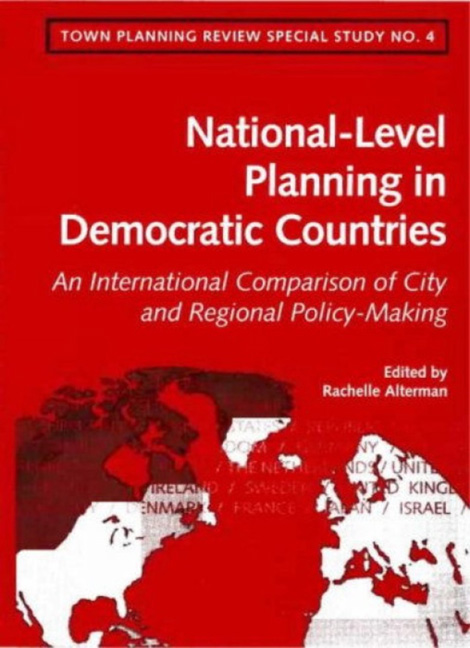 National-Level Spatial Planning in Democratic Countries
National-Level Spatial Planning in Democratic Countries Book contents
- Frontmatter
- Dedication
- Contents
- List of Figures
- List of Tables
- Preface
- About the Contributors
- 1 National-Level Planning in Democratic Countries: A Comparative Perspective
- 2 National Land-Use Planning and Regulation in the United States: Understanding its Fundamental Importance
- 3 Structures for Policy-Making and the Implementation of Planning in the Republic of Ireland
- 4 Rethinking Swedish National Planning
- 5 National-Level Institutions and Decision-Making Processes for Spatial Planning in the United Kingdom
- 6 National-Level Planning Institutions and Decisions in the Federal Republic of Germany
- 7 National-Level Planning in the Danish System
- 8 National-Level Planning Institutions and Decision-Making in France
- 9 National-Level Economic and Spatial Planning in Japan
- 10 Dutch National Planning at the Turning Point: Rethinking Institutional Arrangements
- 11 National-Level Planning in Israel: Walking the Tightrope Between Government Control and Privatisation
2 - National Land-Use Planning and Regulation in the United States: Understanding its Fundamental Importance
- Frontmatter
- Dedication
- Contents
- List of Figures
- List of Tables
- Preface
- About the Contributors
- 1 National-Level Planning in Democratic Countries: A Comparative Perspective
- 2 National Land-Use Planning and Regulation in the United States: Understanding its Fundamental Importance
- 3 Structures for Policy-Making and the Implementation of Planning in the Republic of Ireland
- 4 Rethinking Swedish National Planning
- 5 National-Level Institutions and Decision-Making Processes for Spatial Planning in the United Kingdom
- 6 National-Level Planning Institutions and Decisions in the Federal Republic of Germany
- 7 National-Level Planning in the Danish System
- 8 National-Level Planning Institutions and Decision-Making in France
- 9 National-Level Economic and Spatial Planning in Japan
- 10 Dutch National Planning at the Turning Point: Rethinking Institutional Arrangements
- 11 National-Level Planning in Israel: Walking the Tightrope Between Government Control and Privatisation
Summary
Listed in order of importance, three levels of government in the United States exercise legal authority over land-use planning and regulation: the local level, the state level, and the national level. This article addresses the least important, the national level, concluding that the national government fundamentally does not practise de jure or de facto national land-use planning and regulation as that term would be specified and understood internationally. Instead, local governments and, increasingly, state governments play the dominant role in making and administering plans and regulations affecting the use of land.
Although not the generator of an orchestrated comprehensive national approach, the national government nonetheless has a substantial impact on the use and development of private and public land through an uncoordinated patchwork of national laws, institutions and actions. The five noteworthy patches cover the following areas: first, environmental regulation; second, management of nationally owned land; third, transportation policy and finance; fourth, housing and economic development subsidies; and fifth, anti-land-use planning and regulation. Singly or together, these patches do not assemble themselves into a coherent and comprehensive approach worthy of the sobriquet ‘national land-use planning’.
Terminology
Terminology is too frequently a hobgoblin of international comparative analysis (Alterman and Kayden, 1988, 22–23), so it is wise to specify at the outset the underlying definitions of key words used in this article. In the United States, ‘landuse planning’ and ‘land-use regulation’ are terms regularly employed to describe governmental efforts to guide and control the use and development of land. Unlike usage elsewhere in the world, however, the term ‘land-use planning’ does not subsume the term ‘land-use regulation’. As employed in the United States and in this article, ‘land-use planning’ is a process conducted by the public secctor to analyse and recommend in a comprehensive manner, from social, economic, environmental, infrastructure capacity, aesthetic, and all other relevant aspects, the best present and future uses of geographically specified territories. The usual product of public-sector land-use planning is a ‘land-use plan’, consisting of text and maps, covering a defined area such as a neighbourhood, municipality, or other area. The plan itself does not directly control the use of land, although it may indirectly control use by influencing or directing the very regulation, such as zoning and subdivision, that expressly control such use. ‘National’ land-use planning is land-use planning conducted by national government agencies.
- Type
- Chapter
- Information
- National-Level Spatial Planning in Democratic CountriesAn International Comparison of City and Regional Policy-Making, pp. 43 - 64Publisher: Liverpool University PressPrint publication year: 2001


